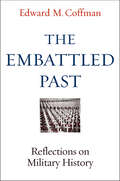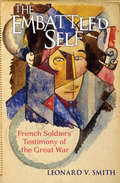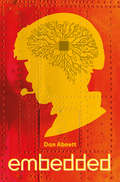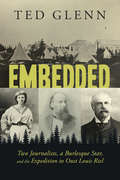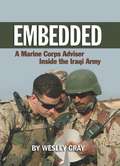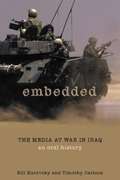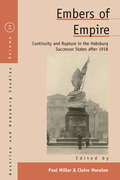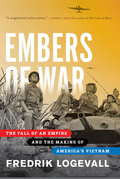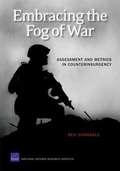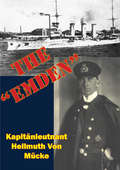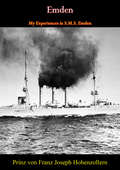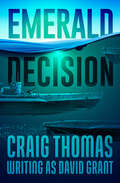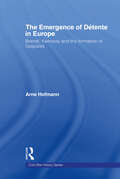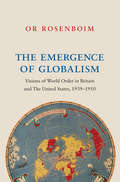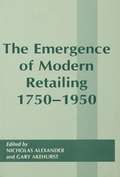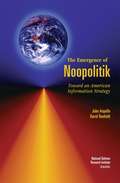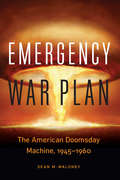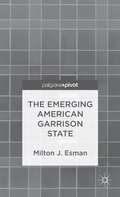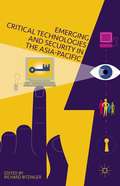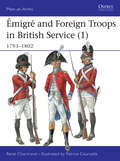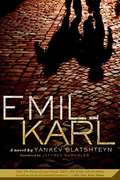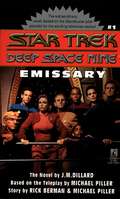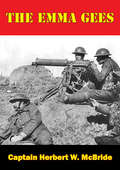- Table View
- List View
The Embattled Past: Reflections on Military History
by Edward M. CoffmanInternationally recognized for having reinvigorated and redefined his field, distinguished military historian Edward M. Coffman is a dedicated and much-admired teacher and mentor. In The Embattled Past, several of his most important essays have been assem
The Embattled Self: French Soldiers' Testimony of the Great War
by Leonard V. SmithHow did the soldiers in the trenches of the Great War understand and explain battlefield experience, and themselves through that experience? Situated at the intersection of military history and cultural history, The Embattled Self draws on the testimony of French combatants to explore how combatants came to terms with the war. In order to do so, they used a variety of narrative tools at hand--rites of passage, mastery, a character of the soldier as a consenting citizen of the Republic. None of the resulting versions of the story provided a completely consistent narrative, and all raised more questions about the "truth" of experience than they answered. Eventually, a story revolving around tragedy and the soldier as victim came to dominate--even to silence--other types of accounts. In thematic chapters, Leonard V. Smith explains why the novel structured by a specific notion of trauma prevailed by the 1930s. Smith canvasses the vast literature of nonfictional and fictional testimony from French soldiers to understand how and why the "embattled self" changed over time. In the process, he undermines the conventional understanding of the war as tragedy and its soldiers as victims, a view that has dominated both scholarly and popular opinion since the interwar period. The book is important reading not only for traditional historians of warfare but also for scholars in a variety of fields who think critically about trauma and the use of personal testimony in literary and historical studies.
Embedded
by Dan AbnettHE'D DO ANYTHING TO GET A STORY. When journalist Lex Falk gets himself chipped into the brain of a combat soldier, he thinks he has the ultimate scoop - a report from the forbidden front line of a distant planetary war, live to the living rooms of Earth. When the soldier is killed, however, Lex has to take over the body and somehow get himself back to safety once more... broadcasting all the way.Heart-stopping combat science fiction from the million-selling Warhammer 40,000 author.File Under: Science Fiction [ Future Warefare | Chipped-In | Anything For a Story | Get Out Alive! ]From the Paperback edition.
Embedded: Two Journalists, a Burlesque Star, and the Expedition to Oust Louis Riel
by Ted GlennA first-hand chronicle of Wolseley’s expedition to end Riel’s Red River Rebellion by a remarkable trio embedded on the mission. In the spring of 1870, two reporters set off from Toronto to cover one of the biggest stories in Canadian history: Colonel Garnet Wolseley’s 1870 expedition to Red River. Over the course of six months, the Daily Telegraph’s Robert Cunningham and the Globe’s Molyneux St. John brought readers along as they paddled and portaged alongside the expedition’s 1,100 troops and 400 voyageurs and guides from the shores of Lake Superior to Fort Garry.But that’s not the whole story. Buried well below the fold was the fact that St. John’s wife — international burlesque star Kate Ranoe — accompanied him and the expedition, and not just as an adventurer. Owing to an accident early on, Ranoe ended up ghostwriting many of St. John’s stories. Embedded is the remarkable story of two reporters and one extraordinary woman as they journeyed to Red River with Colonel Garnet Wolseley and his expeditionary force.
Embedded
by Wesley R. GrayIn 2006, 1st Lt. Wesley Gray was deployed as a U.S. Marine Corps military adviser to an Iraqi Army battalion in the Haditha Triad. For 210 days, he lived and fought beside Iraqi soldiers in the most dangerous and austere province of western Iraq. Al-Anbar was filled with an insurgent population traumatized by a recent massacre of twenty-four men, women, and children shot at close range by U.S. Marines in retaliation for the death of one of their comrades in a roadside bombing. Despite the high tensions created by the shootings, Gray was able to form a bond with the Iraqis because he had an edge that very few U.S. service members possess -the ability to communicate in Iraqi Arabic. His language skills and his understanding of the culture led the Iraqi soldiers to call him a brother and fondly name him Jamal. By the end of his tour he was a legend within the Iraqi Army. Gray draws on the brutally honest and detailed record he kept during his tour, including extensive interviews with Iraqi soldiers and citizens. He offers a comprehensive portrait of the struggles of the Iraqi people to make their country a nation once again and includes a compelling report on the status and prospects of the U.S. government's strategy for success in Iraq.
Embedded: The Media At War in Iraq
by Bill Katovsky Timothy Carlson<P>EMBEDDED is a collection of deeply emotional and highly personal accounts of covering the Iraq War. Many of the world's top war correspondents and photographers speak candidly about life on the battlefield. Here are articulate and heartfelt descriptions of fear and firefights, of bullets and banalities, of risking death and meeting deadlines. <P>With over sixty interviews conducted in Kuwait and Iraq shortly after many returned home, Katovsky and Carlson allowed these journalists to step outside their professional role as journalists and examine the lethal allure of combat reporting. <P>Here is CBS Evening News correspondent Jim Axelrod discussing the perils of racing to Baghdad while despondent over the death of a television colleague and being unexpectedly comforted by ABC News Nightline's Ted Koppel; Newsweek reporter Scott Johnson unwittingly driving into an ambush and then kicking out the windshield of his bullet-riddled car to escape the Iraqi gunmen; New York Times Baghdad Bureau Chief John Burns's brave refusal to be intimidated by his Iraqi information ministry minders; and many, many more. <P>Each interview in EMBEDDED maps its own personal path and narrative arc, while presenting an emotional window to war and reporting. Taken individually, each offers a unique view of the most-covered war in history. Collectively, EMBEDDED is an eyewitness to history that will do for the war in Iraq what Michael Herr's Dispatches did for Vietnam.
Embers of Empire: Continuity and Rupture in the Habsburg Successor States after 1918 (Austrian and Habsburg Studies #22)
by Paul Miller Claire MorelonThe collapse of the Habsburg Monarchy at the end of World War I ushered in a period of radical change for East-Central European political structures and national identities. Yet this transformed landscape inevitably still bore the traces of its imperial past. Breaking with traditional histories that take 1918 as a strict line of demarcation, this collection focuses on the complexities that attended the transition from the Habsburg Empire to its successor states. In so doing, it produces new and more nuanced insights into the persistence and effectiveness of imperial institutions, as well as the sources of instability in the newly formed nation-states.
Embers of War: The Fall of an Empire and the Making of America's Vietnam
by Fredrik LogevallThe struggle for Vietnam occupies a central place in the history of the twentieth century. Fought over a period of three decades, the conflict drew in all the world's powers and saw two of them--first France, then the United States--attempt to subdue the revolutionary Vietnamese forces. For France, the defeat marked the effective end of her colonial empire, while for America the war left a gaping wound in the body politic that remains open to this day. How did it happen? Tapping into newly accessible diplomatic archives in several nations and making full use of the published literature, distinguished scholar Fredrik Logevall traces the path that led two Western nations to lose their way in Vietnam. Embers of War opens in 1919 at the Versailles Peace Conference, where a young Ho Chi Minh tries to deliver a petition for Vietnamese independence to President Woodrow Wilson. It concludes in 1959, with a Viet Cong ambush on an outpost outside Saigon and the deaths of two American officers whose names would be the first to be carved into the black granite of the Vietnam Veterans Memorial. In between come years of political, military, and diplomatic maneuvering and miscalculation, as leaders on all sides embark on a series of stumbles that makes an eminently avoidable struggle a bloody and interminable reality. Logevall takes us inside the councils of war--and gives us a seat at the conference tables where peace talks founder. He brings to life the bloodiest battles of France's final years in Indochina--and shows how from an early point, a succession of American leaders made disastrous policy choices that put America on its own collision course with history: Harry Truman's fateful decision to reverse Franklin Delano Roosevelt's policy and acknowledge France's right to return to Indochina after World War II; Dwight Eisenhower's strenuous efforts to keep Paris in the fight and his escalation of U.S. involvement in the aftermath of the humiliating French defeat at Dien Bien Phu; and the curious turnaround in Senator John F. Kennedy's thinking that would lead him as president to expand that commitment, despite his publicly stated misgivings about Western intervention in Southeast Asia. An epic story of wasted opportunities and tragic miscalculations, featuring an extraordinary cast of larger-than-life characters, Embers of War delves deep into the historical record to provide hard answers to the unanswered questions surrounding the demise of one Western power in Vietnam and the arrival of another. This book will become the definitive chronicle of the struggle's origins for years to come.Advance praise for Embers of War "Fredrik Logevall has gleaned from American, French, and Vietnamese sources a splendid account of France's nine-year war in Indochina and the story of how the American statesmen of the period allowed this country to be drawn into the quagmire."--Neil Sheehan, author of A Bright Shining Lie, winner of the Pulitzer Prize and the National Book Award "Fredrik Logevall is a wonderful writer and historian. In his new book on the origins of the American war in Vietnam, he gives a fascinating and dramatic account of the French war and its aftermath, from the perspectives of the French, the Vietnamese, and the Americans. Using previously untapped sources and a deep knowledge of diplomatic history, Logevall shows to devastating effect how America found itself on the road to Vietnam."--Frances FitzGerald, author of Fire in the Lake, winner of the Pulitzer Prize and the National Book Award
Embracing the Fog of War: Assessment and Metrics in Counterinsurgency
by Ben ConnableThe unpredictable counterinsurgency environment challenges centralized, quantitative campaign assessment. A comprehensive examination of the centralized, quantitative approach to assessment, as described inthe literature and doctrine and applied in two primary case studies (Vietnam and Afghanistan), reveals weaknesses and gaps and proposes an alternative process: contextual assessment.
The “Emden”
by Kapitänleutnant Hellmuth Von MückeThe cruiser SMS Emden was part of the German East Asia Squadron based at the Tsingtao in China during the First World War. Designed to be a commerce raider, attacking Allied merchant shipping rather than fleet battle action, she achieved much more than that under the command of her swashbuckling commander Kapitän zur See Karl Friedrich Max von Müller. From the outbreak of hostilities she began to attack the shipping lanes, vital to the Allies, sinking and capturing over 20 vessels in the first few months. She then surprised and sank a Russian cruiser and a French destroyer in the audacious raid on Penang before heading for the Cocos Islands to wreck British naval assets there. Unfortunately for the Emden and her crew, they were hunted down by the more powerful HMAS Sydney and the raider was forced to run aground. The epic efforts of the Emden and her crew are herein brought to life through the memoirs of her First officer, Kapitänleutnant Hellmuth Von Mücke.Following the end of the Emden the majority of the surviving crew were captured, but Von Mücke led a group all the way back to Germany in the commanded schooner Ayesha - this epic journey is told in a companion book the "Ayesha".
Emden: My Experiences in S.M.S. Emden
by Prinz Franz Joseph von HohenzollernDuring World War I, Franz Joseph Prinz von Hohenzollern served in Germany’s Kaiserliche Marine (Imperial Navy) as the second torpedo officer on the light cruiser SMS Emden at the Battle of Cocos. The SMS Emden had an extraordinary record capturing British ships. This book, which was first published in its English translation in 1928, is a fascinating record of Franz Joseph’s naval service on the SMS Emden.SMS Emden (“His Majesty’s Ship Emden”) was the second and final member of the Dresden class of light cruisers built for the Imperial German Navy (Kaiserliche Marine). Named after the town of Emden, she was laid down at the Kaiserliche Werft (Imperial Dockyard) in Danzig in 1906. Her hull was launched in May 1908, and completed in July 1909. She had one sister ship, Dresden. Like the preceding Königsberg-class cruisers, Emden was armed with ten 10.5 cm (4.1 in) guns and two torpedo tubes.Emden spent the majority of her career overseas in the German East Asia Squadron, based in Tsingtao, in the Kiautschou Bay concession in China. In 1913, she came under the command of Karl von Müller, who would captain the ship during WWI. At the outbreak of hostilities, Emden captured a Russian steamer and converted her into the commerce raider Cormoran. Emden rejoined the East Asia Squadron, after which she was detached for independent raiding in the Indian Ocean. The cruiser spent nearly two months operating in the region and captured nearly two dozen ships. On October 28, 1914, Emden launched a surprise attack on Penang; in the resulting Battle of Penang, she sank the Russian cruiser Zhemchug and the French destroyer Mousquet.The SMS Emden’s extraordinary record capturing British ships resulted in all those who served on her, including Franz Joseph, being given the right to add the ship’s name to the end of their surnames.
Emerald Decision
by Craig ThomasIn this New York Times–bestselling thriller, the son of a WWII spy delves into an explosive decades-old secret amid tensions between England and Ireland . . . 1940: McBride, an Anglo-Irish spy, discovers a secret nest of Nazi submarines in Guernsey. As a minefield on the Irish coast is breached and German agents flow into the country—a desperate decision must be made in order to prevent the impending invasion in Britain. The consequences are deadly—and the story is kept top secret for decades . . . 1980: McBride&’s American son, an author, starts to dig into the history and mystery surrounding &“the Emerald decision&”—not realizing his own personal connection to it. And even after all these years, certain parties are willing to kill to keep the story a secret—or to exploit it . . . &“The great strength of [Thomas&’s] books lies . . . in the presentation of powerfully exciting bouts of action in authentically realized settings.&” —Reginald Hill, Books and Bookmen Originally published under the pseudonym David Grant
The Emergence of Détente in Europe: Brandt, Kennedy and the Formation of Ostpolitik (Cold War History)
by Arne HofmannThis book examines the key relationship between Willy Brandt (the former Mayor of West Berlin and future West German Chancellor) and the administration of President John F. Kennedy. Arne Hofmann focuses on the administration’s influence on the development of Brandt’s ‘policy of small steps’ and the formation of his later Ostpolitik, the centrepiece of European détente. Brandt’s interaction with the Kennedy administration is traced through the Berlin Wall crisis of 1961, together with Kennedy’s search for a modus vivendi based on the status quo, the 1962 crisis in German-American relations, Brandt’s disillusionment campaign, the development of his programmatic statements, Brandt’s three meetings with the President including Kennedy’s famous visit to Berlin, the limited nuclear test ban treaty and Brandt’s Berlin pass agreement of Christmas 1963. While the narrative focuses on the gradual change in Brandt’s position, systematic parts concentrate on Brandt’s and Kennedy’s détente concepts, the triangular relationship between West Berlin, Washington and Bonn with its implication for domestic politics, and the role of images, campaigning and public opinion. The Emergence of Détente in Europe will appeal to students of Cold War history, foreign policy, international relations and international history in general.
The Emergence of Globalism: Visions of World Order in Britain and the United States, 1939-1950
by Or RosenboimDuring and after the Second World War, public intellectuals in Britain and the United States grappled with concerns about the future of democracy, the prospects of liberty, and the decline of the imperial system. Without using the term "globalization," they identified a shift toward technological, economic, cultural, and political interconnectedness and developed a "globalist" ideology to reflect this new postwar reality. The Emergence of Globalism examines the competing visions of world order that shaped these debates and led to the development of globalism as a modern political concept.Shedding critical light on this neglected chapter in the history of political thought, Or Rosenboim describes how a transnational network of globalist thinkers emerged from the traumas of war and expatriation in the 1940s and how their ideas drew widely from political philosophy, geopolitics, economics, imperial thought, constitutional law, theology, and philosophy of science. She presents compelling portraits of Raymond Aron, Owen Lattimore, Lionel Robbins, Barbara Wootton, Friedrich Hayek, Lionel Curtis, Richard McKeon, Michael Polanyi, Lewis Mumford, Jacques Maritain, Reinhold Niebuhr, H. G. Wells, and others. Rosenboim shows how the globalist debate they embarked on sought to balance the tensions between a growing recognition of pluralism on the one hand and an appreciation of the unity of humankind on the other.An engaging look at the ideas that have shaped today's world, The Emergence of Globalism is a major work of intellectual history that is certain to fundamentally transform our understanding of the globalist ideal and its origins.
The Emergence of Modern Retailing 1750-1950
by Nicholas Alexander Gary AkehurstThe history of retail business development is an under-researched area. This book considers the emergence and development of modern retailing from an historical and management perspective in the period 1750-1950, addressing the need for further research and providing examples of current research activity. It considers the early emergence of retail forms in the late eighteenth century, the evolution of retail forms in the nineteenth century, and the late adaptation of retail management in the early twentieth century.
The Emergence of Noopolitik
by David Ronfeldt Elizabeth Williams Dionne Barnes-Proby John Arquilla John ChristianStrategy, at its best, knits together ends and means, no matter how various and disparate, into a cohesive pattern. In the case of a U.S. information strategy, this requires balancing the need to guard and secure access to many informational capabilities and resources, with the opportunity to achieve national aims by fostering as much openness as practicable. The authors' term to represent such strategic balancing is guarded openness. They go on to describe noopolitik (nu-oh-poh-li-teek)--an emerging form of statecraft that emphasizes the importance of sharing ideas and values globally, principally through the exercise of persuasive soft power rather than traditional military hard power. This study discusses the opportunities that may be raised by the emergence of noopolitik--ranging from construction of a noosphere (a globe-spanning realm of the mind) to recommendations that, for example, the U.S. military should begin to develop its own noosphere (among and between the services, as well as with U.S. allies). In the area of international cooperation, the authors offer strategic approaches for improving the capacity of state and nonstate actors to work together to address transnational problems. In addition, the authors recommend specific doctrinal developments, implied by the emergence of information strategy--including the pressing need to deal with such ethical concerns as the first use of information weapons, concepts of proportional response, and the need to maintain the immunity of noncombatants. Ultimately, the authors call for an innovative turn of mind as policymakers and strategists rethink how best to adapt to the epochal transformations being wrought by the information revolution.
Emergency Deep
by Michael DimercurioIslamic terrorists acquire the deadliest submarine in the world
Emergency War Plan: The American Doomsday Machine, 1945–1960
by Sean M. MaloneyEmergency War Plan examines the theory and practice of American nuclear deterrence and its evolution during the Cold War. Previous examinations of nuclear strategy during this time have, for the most part, categorized American efforts as &“massive retaliation&” and &“mutually assured destruction,&” blunt instruments to be casually dismissed in favor of more flexible approaches or summed up in inflammatory and judgmental terms like &“MAD.&” These descriptors evolved into slogans, and any nuanced discussion of the efficacy of the actual strategies withered due to a variety of political and social factors. Drawing on newly released weapons effects information along with new information about Soviet capabilities as well as risky and covert espionage missions, Emergency War Plan provides a completely new examination of American nuclear deterrence strategy during the first fifteen years of the Cold War, the first such study since the 1980s. Ultimately what emerges is a picture of a gargantuan and potentially devastating enterprise that was understood at the time by the public in only the vaguest terms but that was not as out of control as has been alleged and was more nuanced than previously understood.
The Emerging American Garrison State
by Milton J. EsmanThis book describes and analyzes the emergence of the American global empire and the role of the garrison state in protecting the threatened homeland and defending the declining imperium.
Emerging Critical Technologies and Security in the Asia-Pacific
by Richard BitzingerThe proliferation of advanced militarily relevant technologies in the Asia-Pacific over the past few decades has been a significant, and perhaps even alarming, development. This volume addresses how such technologies may affect military capabilities and military advantage in the region.
Émigré and Foreign Troops in British Service
by Rene Chartrand Patrice CourcelleFollowing the Revolution in 1789, members of the aristocracy were increasingly persecuted, and many of them fled abroad. These exiles became known collectively as 'émigrés', and despite initial confusions and indecision, many of them were taken into British service. This fine text by René Chartrand examines the organisation, uniforms and insignia of the Émigré troops in British service from 1793 to 1802, accompanied by plenty of illustrations including eight full page colour plates by Patrice Courcelle.
Emil and Karl
by Yankev Glatshteyn Jeffrey ShandlerThis is a unique work. It is one of the first books written for young readers describing the early days of the event that has since come to be known as the Holocaust. Originally written in Yiddish in 1938, it is one of the most accomplished works of children's literature in this language. It is also the only book for young readers by Glatshteyn, a major American Yiddish poet, novelist, and essayist. Written in the form of a suspense novel, Emil and Karl draws readers into the dilemmas faced by two young boys one Jewish, the other not when they suddenly find themselves without families or homes in Vienna on the eve of World War II. Because the book was written before World War II, and before the full revelations of the Third Reich's persecution of Jews and other civilians, it offers a fascinating look at life during this period and the moral challenges people faced under Nazism. It is also a taut, gripping, page-turner of the first order.
Emissary (Star Trek: Deep Space Nine #1)
by J.M. DillardAn original novel based on the acclaimed Star Trek TV series! Commander Benjamin Sisko is just recovering from the death of his wife when he is assigned command over the former Cardassian, but new Federation space station, Deep Space Nine. This space station is strategically located not only because of its orbit about Bajor, but also because of its proximity to the only known stable wormhole in the galaxy. After meeting the other Bajoran and Starfleet personnel assigned to the station, including a former Bajoran freedom fighter and a shapeshifter, Sisko finds himself in that very wormhole and in the midst of a metaphysical experience as the alien inhabitants of the wormhole question the concepts of time and love. Sisko, filled with humanistic hubris, begins to explain these experiences, and resolve his painful past.
The Emma Gees [Illustrated Edition]
by Captain Herbert W. McBrideIncludes the First World War Illustrations Pack - 73 battle plans and diagrams and 198 photosThe classic account of sniping on the Western Front."Herbert Wesley McBride was a Captain in the Twenty-first Battalion, Canadian Expeditionary Force, during the First World War. He was a sniper and commander of a machine gun unit known as the "Emma Gees." He was also the author of two books on the war: "A Rifleman Went To War" (1933) and "The Emma Gees" (1918)...When the war started, he volunteered in a Canadian rifle company in Ottawa because he wanted to see action as quickly as possible. He was commissioned as an officer, but was reduced to a private due to several drunken incidents. He shipped to England for training and then to the Western Front, where he participated in battles around Ypres and the Somme throughout 1916. In his book, "A Rifleman Went To War," he recounts killing more than 100 German soldiers as a sniper. This book is highly regarded by students of riflery, it's mandatory reading in the U.S. Marine Corps Sniping School. It is also considered one of the best first-person accounts of World War I, often being compared favorably to "Storm of Steel" by Ernst Junger. However McBride notes in his book that by the end of 1916 he felt in his heart "the game was over," and a series of alcoholic binges resulted in his court martial and dismissal from the Canadian Expeditionary Force in February 1917. He then joined the United States Army's 38th Division, serving out the war as a marksmanship and sniping instructor at Camp Perry. He resigned in October 1918. After the war, he worked in the lumber industry in Oregon for most of his later years. He died in Indianapolis of a sudden heart failure on March 17, 1933, shortly after finishing "A Rifleman Went To War." He was 60."-Canadaatwar.com
Emmerdale at War: an uplifting and romantic read perfect for nights in (Emmerdale, Book 3) (Emmerdale)
by Pamela BellThe perfect Christmas gift full of warmth and nostalgia, for fans of ITV's Emmerdale, and readers who love heartwarming and heartbreaking stories set during World War II.Britain is at war once again and the families of Emmerdale are trying their best to cope with a new way of life.Rationing has been introduced across the country, two million more men have been called up for service, and blackouts, evacuees and military training camps have become the norm. In Beckindale, three young women are about to find their lives changed forever...Annie Pearson is working on Emmerdale Farm, while her love, Edward Sugden is at the front line. Lily Dingle has found purpose in joining the ATS, though she may get more than she bargained for. And Meg Warcup, now teaching at the local school, has taken in two children evacuated from Hull. They've adjusted to their new way of life until one day a German plane comes crashing down in the village... and changes everything in the village of Beckindale.The third novel in the Emmerdale series transports us to the Yorkshire Dales in the midst of World War II, exploring the lives of Emmerdale's much-loved families. Will the nation's favourite village overcome adversity to deal with the loves and lives lost?
